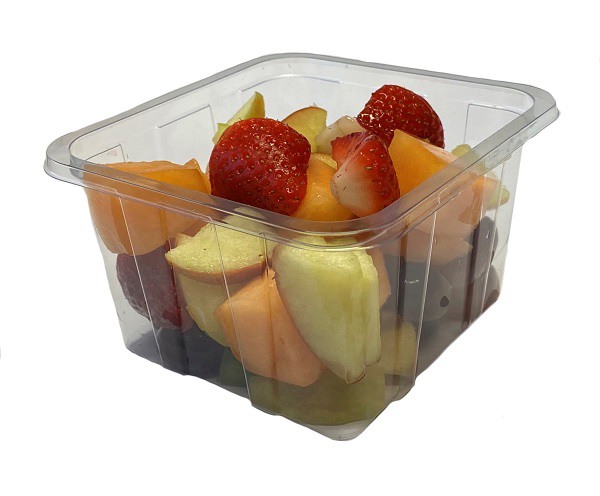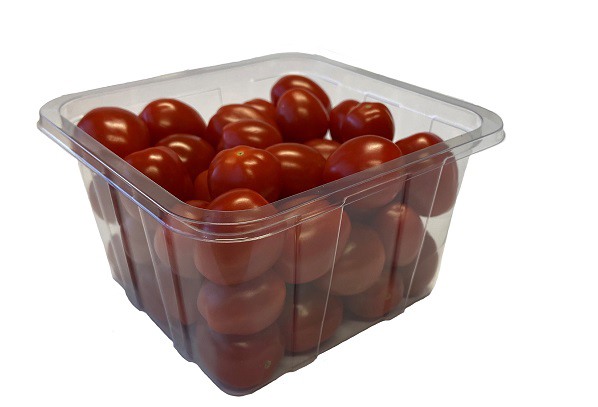Durability, protection during transport, and presentation are just a few reasons why many fruit and vegetable products are packaged. "Some products, like sliced vegetables and soft fruit, simply cannot do without packaging, and certain products stay fresh longer when packaged correctly," says Gert Kolkman of Kolkman Verpakkingen. This Dutch company produces packaging using two types of plastic: (up to) 100% recycled R-PET and PP.

Is eco-friendly plastic the best option?
R-PET is recycled (R) plastic (PET). PET stands for polyethylene terephthalate and is polyester. R-PET is made from previously used PET plastic, like well-known soft drink PET bottles, but also from other packaging. "The packaging we produce from R-PET is largely made from 100% recycled plastic. So we use no new raw material. A major advantage is that this packaging is also fully recyclable, making an endless cycle possible. Our material can be reused again and again."
Gert thinks R-PET is the most eco-friendly fruit and vegetable packaging out there. This circular material can be reused in the same chain, protects the products well, and is safe for consumer use. R-PET can be hermetically sealed so no virus particles can reach the product. Also, R-PET is very transparent and easy to process.
"PP materials have a big disadvantage - you aren't allowed to reuse them in the food chain. Partly because of this, you can only "downcycle" it. So why do we use it anyway? Some products need to be warmed up while still in our package. You can't do that with an R-PET package, but PP is perfect for this."
"Downcycling means that although you can recycle the material, its quality is constantly deteriorating. Still, you can make things like excellent furniture or traffic poles from the original, great plastic container. However, we focus on using recycled PET (R-PET) to produce new packaging because we believe that 100% R-PET is the solution of our time," explains Gert.
What is the story with paper, then?
Paper and cardboard have a good image, but is that justified? "Paper comes from trees, trees are green, green is good. At least, that's what people think." And that is partly true. Paper has the advantage that it breaks down faster in nature. "But everyone understands that replacing the plastic litter along the highway, or even worse, the 'plastic soup' in the oceans, with paper and cardboard, isn't the answer."
"On top of that, producing paper uses up to four times as much water and produces three times more greenhouse gasses. We've done projects offering cardboard trays for some of our customers. Our research shows that using cardboard versus plastic to package the same product weighs 1.5 times as much. Just think about the added CO2 emissions for those clients doing hundreds of loads a year," Kolkman says.

You can recycle paper well, too, though, and some new cardboard packaging may contain waste paper. "This is called downcycling. You may not recycle paper food packaging into second-generation cardboard food packaging after use. It's good that this material can be reused, but it does lose its value."
"Paper fiber loses more and more of its structure during recycling. As a result, cardboard packaging has a limited lifespan. Also, in the food industry, moist products have to be packaged, and paper and cardboard aren't naturally suited to this. You have to give them additional treatment to make them moisture-resistant," Gert continues.
Are there other sustainable alternatives?
PLA plastic is a biodegradable, compostable material made from renewable plant-based raw materials like cornstarch or sugar cane. It is therefore presented as a sustainable alternative to traditional plastics. What does Kolkman Packaging think of this? "This material still has too little added value. It cannot be produced efficiently enough yet. But fortunately, they're working hard to improve that."
"Also, it's much harder to get PLA, which makes it far more costly. PLA can be recycled but is practically impossible to separate. When people separate their trash at home, they find it difficult to distinguish between PLA and R-PET. Often, the PLA material ends up with plastic waste, while theoretically, it should go in the organic waste container. So, for now, no PLA, but developments are moving fast in the plastics world, so we're keeping a close eye on this," Gert says.
Supermarkets ban single-use plastics
Gert is glad single-use plastic waste is being reduced. Unnecessary packaging is disappearing or being replaced with sustainable alternatives. Yet, more thought could go into certain packagings, like for meat, he says. For example, minced meat used to come in a tray; supermarkets are increasingly replacing those for plastic bags." It's a good idea because it uses much less plastic. Yet these bags still end up in waste processors' incinerators because it's difficult, if not impossible, to separate the materials."
"Packaging with a digital code could be the answer. These are excellent for sorting. We hope digital codes will be done using, say, CurveCode. Our latest products with these CurveCodes are already on various retail store shelves. We have to wait for the test results, but we can use this code to sort out, reprocess, and reuse 100% R-PET used for food products for food-safe packaging," Gert concludes.
Gert Kolkoman
Kolkman Verpakkingen Hedel
Architronlaan 3
5321 JJ Hedel
Tel: +31 (0) 73 5992255
g.kolkman@kvh.nl
www.kvh.nl
